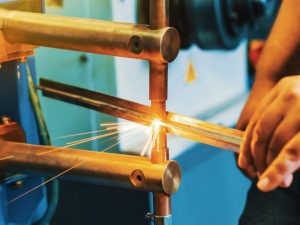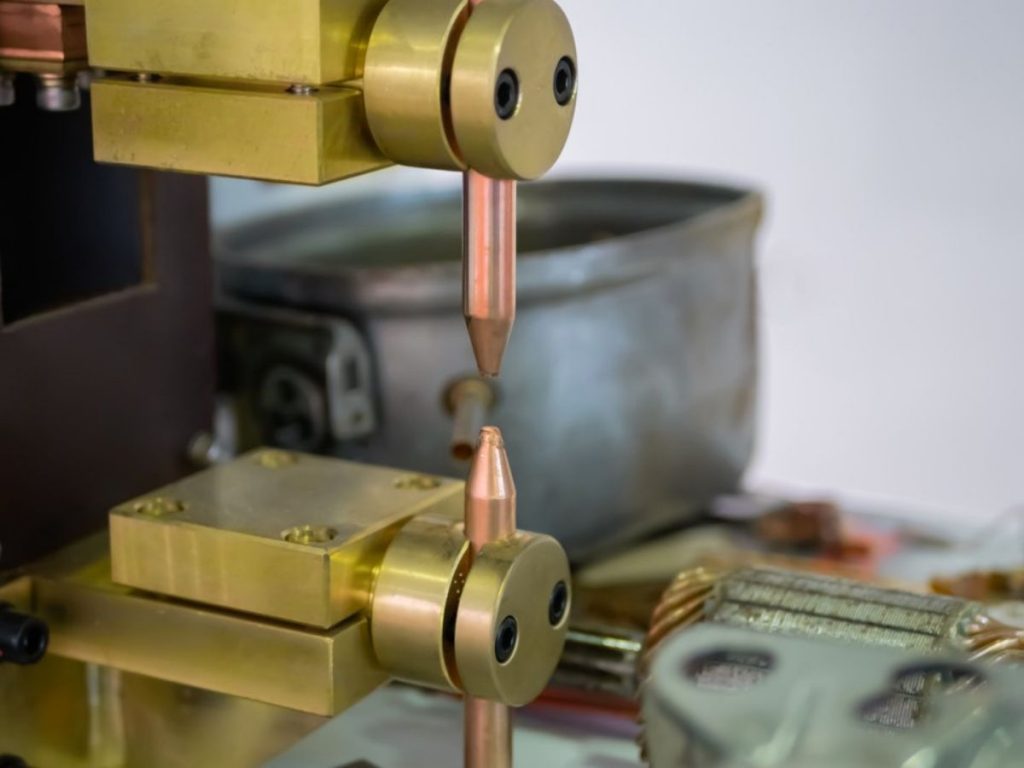There are many questions surrounding Spot Welding. Some ask what is it used for, while others want to know how it works and what the advantages and disadvantages are. The following will provide you with an understanding of the process and its benefits and drawbacks. Welding metal parts with a spot welder is fast, safe, and economical.
What is Spot Welding Used For?
Spot welding is a process wherein two pieces of metal are joined together using a small electrical arc. Unlike MIG welding, where a separate piece of filler metal is melted and then joined to the base metal, spot welding uses the metal itself as the filler metal. The two pieces are then pressed together in the desired shape, resulting in a welded joint.
A spot-welding machine consists of electrodes and tool holders. The tool holders hold the electrodes in place and can also hold water hoses. The electrodes are made of copper or a low-resistance alloy and can come in a variety of sizes and shapes. The electrodes are cooled using coolant holes. The coolant may be water or a brine solution.
The process of spot welding uses copper-chromium electrodes to create welds. It is used to weld low carbon steels and high carbon steels. It is also a popular method for welding delicate electrical components, because it prevents overheating. Spot welding is also commonly used to form nails. Carbon steel rolls are subjected to an electric current to melt them into nails. The process can be carried out continuously and at high speeds, resulting in thousands of nails per minute. Spot welding can also be used to form handles for spatulas, tin cups, and other metal straps.
How Does Spot Welding Work?
Spot welding uses electrodes to produce heat in a limited area. These electrodes are held or squeezed to the metal sheets. The holding pressure allows the welded nugget to cool. The amount of current applied to the weld area depends on the type of workplace and its thickness. The time it takes to weld will also depend on the electrode used.
The electrodes used in spot welding must match the material being welded. Copper electrodes are the most common, but some applications require tungsten or molybdenum electrodes. Copper-chromium-zirconium electrodes are also viable choices for welding low-carbon steel.
Resistance spot welding is commonly used in the automotive industry, where a single vehicle may have over 1,000 spot welds. This welding process is also used in manufacturing, aerospace, rail, electronics, and batteries. In industrial settings, spot-welding robots complete the process in a few seconds.
What are the advantages of Spot Welding?
The advantages of spot welding over other welding processes include the lack of filler metals and gasses, fast joining and minimal heat transfer. It also requires less power than other welding processes and is easy to operate. But there are some disadvantages to spot welding. This type of welding is not suitable for many materials and applications.
When using spot welding, you need to apply the proper amount of pressure for a proper weld. Using too much pressure will result in a crack in the welded area. You should apply about 25 percent of the thickness of your workpiece. This will avoid damage to the base material.
Spot welding is an efficient method for joining metal sheets, even if they are thicker than 3mm. The process is ideal for automation and is often used in automotive body construction. It is also used in the electronics industry to manufacture relay contact sets and capacitors.
What are the disadvantages of Spot welding?
While spot welding can be very useful for a wide range of applications, it does have some disadvantages. One of these is that it can only be used for a small area. This means that electrodes must be squeezed tightly against the metal sheets in order to produce the desired heat. This method also requires repositioning the electrodes each time you want to perform a welding session.
It is also unattractive to the eye. Its low penetration power makes it a poor choice for welding thin strips. As a result, it is mostly used for internal applications. Furthermore, spot-welding guns are heavy and require a lot of strength. Another disadvantage of spot welding is that it exposes the welder to high levels of heat and welding fumes. These fumes can cause eye damage and second and third-degree burns, so it’s best to work with gloves and eye protection when spot welding.
The electrodes used for spot welding are made of copper alloy. The welding current used is typically between 1000 and ten thousand amperes. Depending on the thickness and composition of the metal pieces, this current can flow for just a few seconds or a few minutes. Spot welding is most often used in the automobile and aerospace industries, but it is also used in the fabrication of braces and pads.

Spot Welding Variables
In the process of spot welding, there are various variables that affect the quality of the weld. These variables vary in frequency. Lower frequencies produce better quality welds. However, higher frequencies are easier to parameterize. As the contact surface of the electrode increases, adjusting the weld parameters will become more difficult.
Various experiments have been conducted to study the influence of spot welding variables on the tensile-shear force of lap joints. These tests were carried out for various materials, including steel and aluminum. The resulting welded joints were studied by using the Taguchi design, a mathematical model for spot welding. The study aims to identify the optimal input and response parameters to improve welded joints.
One of the main variables that determine the quality of spot welds is the temperature. Too high a temperature causes a weld to be too soft. When this happens, the material runs out of heat. As a result, the weld ends up as a hole.
Spot Welding Different Materials
There are many different types of spot-welding materials. Some are more difficult to weld than others. For example, aluminum has a lower melting point than copper. This means that welding aluminum requires a much higher current. However, there are some new technologies that make it possible to weld aluminum with a high quality.
Spot welding is a common process in the manufacturing of many different types of metal products. This method is particularly useful for delicate electronic parts since it produces a very fine weld without overheating them. In addition, it is a convenient way to join two materials that have different thicknesses. The electrode used is the same size as the thicker piece, so it’s important to match the thickness of the sheet before welding. The thickness ratio should be at least three to one to produce the highest quality weld.
When spot-welding different materials, you need to remember that the electrodes need to be cooled to prevent the weld from cracking. This is important because if the electrodes are allowed to stay too long, the heat will spread out and cause the weld to be weak and brittle. You can also vary the electrode pressure and weld current to obtain a higher quality weld. Another important parameter to consider is the squeeze time. The squeeze time refers to the amount of time the electrode applies pressure to the surface.
Common Spot Welding Problems
Common spot welding problems can result in weaker metal and reduced strength. In addition, improper placement of spot welds can lead to distortion of the sheet metal. In such cases, the sheet metal may need to be replaced. To prevent such problems, the electrodes used in spot welding should be precisely controlled. Using too little or too much pressure can reduce the resistance of the metal to the electrical current and prevent the metal from reaching the proper welding temperature.
During spot welding, the amount of energy that the electrodes deliver to the spot is determined by the resistance between them and by the length of the current. It is also important to note that the electrical energy delivered to a spot must be chosen to match the properties of the sheet material and the type of electrodes used. Too little energy can lead to insufficient melting of the metal, while too much energy can cause a hole to form in the metal.
In the case of aluminum alloy spot welding, it is important to use a high-current and a long machining time to ensure the optimum weld quality. Otherwise, the resulting welds will be uneven and can lead to unbalanced nuggets. This is not desirable from a joint strength standpoint. Fortunately, the process tape can help avoid these problems and improve welding quality.
Conclusion
Spot welding involves applying a small amount of energy to a small area of a workpiece. The heat produced by this process softens the interface between the electrode and the material. The clamping force also helps to smooth the interface. However, the application of too much energy will result in a failed weld, which is a hole.
As with any weld, the time of holding should be measured carefully to avoid over-stretching the weld and wearing out the electrodes. In addition, it is recommended to limit the holding time for high-carbon materials, as long-standing holds can cause cracks. Another common mistake that causes weak welds is removing the electrodes before the nuggets have solidified.
The amount of energy delivered to the spot is dependent on the resistance between the two electrodes and the magnitude and duration of the current. The amount of energy used should be suitable for the thickness of the metal sheet and its properties. The application of too much energy will result in a hole, while too little energy will not melt the metal.

